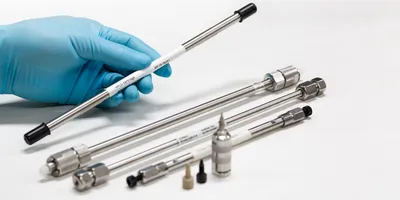Chromatography columns play a vital role in analytical and preparative processes across scientific disciplines, from environmental testing to pharmaceutical research. Whether you are using gas chromatography (GC) columns or high-performance liquid chromatography (HPLC) columns, ensuring column safety is essential for protecting laboratory personnel, preventing equipment damage, and maintaining data accuracy.
General Chromatography Column Safety Precautions
Working with chromatography columns involves high pressures, fragile materials, and potentially hazardous chemicals. Always follow the manufacturer’s instructions for installation, operation, and maintenance to ensure safe and effective use.
- Read the User Manual: Each column type has unique specifications, handling procedures, and limitations. Become familiar with these before installation and use.
- Inspect Columns Before Use: Check for any visible damage, including cracks, deformities, or compromised connections, before installing a column.
- Use Compatible Fittings and Tubing: Ensure all fittings, tubing, and connectors match the column type and pressure rating to prevent leaks and failures.
Gas Chromatography (GC) Column Safety
Handle Capillary Columns with Care
Capillary columns, especially those made of fused silica or glass, are extremely fragile. Mishandling can easily lead to breakage, which could result in injury or costly replacement.
- Always wear safety glasses when handling, cutting, or installing GC capillary columns to protect your eyes from potential flying glass particles.
- Use proper cutting tools when trimming capillary columns to ensure clean, smooth ends that minimize leaks and improve chromatographic performance.
- Minimize bending and twisting to avoid fractures and maintain the column's structural integrity.
Follow Proper Installation Procedures
- Ensure the system is depressurized before column installation.
- Secure fittings gently but firmly to avoid overtightening, which can damage the column ends.
- Avoid contaminants by wearing gloves and handling only the exterior non-active surfaces.
Allow Columns to Cool Before Changing
Columns operating at elevated temperatures must cool down fully before handling or removal to prevent burns or thermal stress damage.
Pressure Management
- Monitor pressure regularly to ensure the column operates within manufacturer-recommended limits.
- Investigate sudden pressure drops or spikes, which could indicate leaks, blockages, or damage.
High-Performance Liquid Chromatography (HPLC) Column Safety
Observe Maximum Working Pressure
HPLC columns are designed to operate at specific pressure ranges, depending on the packing material and column dimensions. Exceeding the recommended working pressure can lead to:
- Column degradation
- Leaks
- Rupture of fittings or connectors
- Loss of packing material
🚨 Always consult the manufacturer’s specifications and configure your instrument’s pressure limits accordingly.
Proper Installation and Maintenance
- Ensure proper alignment of column connections to avoid leaks and backpressure issues.
- Prime the system with compatible solvents to avoid introducing air bubbles into the column, which can damage the packing material.
- Condition the column appropriately before analysis by equilibrating with the mobile phase under recommended flow rates and pressures.
Thermal Safety
Allow the column to cool to ambient temperature before removal to prevent accidental burns and to maintain the integrity of both the column and surrounding components.
Safe Chemical Handling
HPLC often involves hazardous solvents and mobile phases. Follow chemical safety guidelines, including proper ventilation, use of gloves, and protective eyewear when preparing or disposing of mobile phases.
Storage and Disposal Considerations
- Store columns upright in appropriate protective cases to prevent damage.
- Flush columns with recommended solvents before long-term storage to remove residual materials that could degrade the packing.
- Label stored columns with information on the last mobile phase and conditions used.
- Dispose of damaged columns according to laboratory hazardous waste policies, especially if contaminated with hazardous materials.
Training and Safety Culture
Ensure all laboratory personnel receive proper training on chromatography system operation, column handling, and emergency response procedures. Establishing a strong safety culture around chromatography operations reduces the risk of accidents and enhances overall laboratory safety.
Final Thoughts
Chromatography column safety involves a combination of proper handling techniques, adherence to manufacturer guidelines, and attention to laboratory safety best practices. By treating columns with care and maintaining a well-documented operational procedure, laboratories can enhance data quality, extend the lifespan of valuable columns, and protect both personnel and equipment.
Frequently Asked Questions (FAQ)
1. Why is it important to follow manufacturer recommendations for chromatography columns?
Manufacturer recommendations provide essential information on pressure limits, chemical compatibility, and installation procedures, ensuring safe operation and optimal column performance.
2. What protective equipment should I wear when handling chromatography columns?
At minimum, wear safety glasses when handling fragile capillary columns and gloves when handling HPLC columns, particularly when working with hazardous solvents.
3. Can I reuse a chromatography column after exceeding the recommended pressure?
Exceeding the recommended pressure can damage column packing and reduce column efficiency. Inspect performance using test standards and only continue use if performance meets acceptance criteria.
4. How often should chromatography columns be inspected?
Visually inspect columns before each use and monitor backpressure and peak shape during operation to detect potential issues early.
This content includes text that has been generated with the assistance of AI. Lab Manager’s AI policy can be found here.











